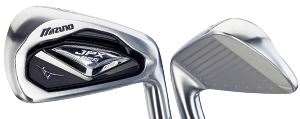Golf club acoustics are an increasingly technical aspect of club design. Designers from golf’s top brands tell us why … and reveal how they create that satisfying impact sound.
 Designers balance harsh sounds created by thin, powerful faces by stiffening parts of the head’s perimeter, as in Mizuno’s JPX 825.
Designers balance harsh sounds created by thin, powerful faces by stiffening parts of the head’s perimeter, as in Mizuno’s JPX 825.Good – and bad – vibrations
While the sole of every iron is generally solid and rarely causes unwanted vibration and noise, things are different in the upper and high-toe regions of the face. “These zones are thinner, and naturally attract more vibration,” says Mizuno’s David Llewellyn.
“This is why our new JPX models feature a subtle angled brace out on high toe to add rigidity to these weaker zones. The pocket cavity used in the JPX 825 Pro and the MP 53 is a weight-saving strategy, allowing us to add these braces without adding extra mass to the clubhead.”
Golf’s changing soundtrack - Todd Beach TaylorMade VP of R&D, metal woods
“We might think of a pleasing impact sound as a constant; but like gear itself, it has its own trends. Sound definitely migrates over time.
“Back in 1979, when our first steel-headed woods came out, we were having to put foam in the head to dampen the sound because people liked the sound of persimmon. In fact the sound of the driver was the only really problem the Tour pros had with those early metal woods.
“But when titanium came out – we launched the Ti Bubble 2 in 1996 – heads got bigger. In fact at 285cc, the Ti Bubble 2 practically doubled previous head sizes. Suddenly, the amount of foam we were having to use began to affect the performance of the club, so we took it out. Sure, the club sounded louder, but people began to associate that louder sound with the performance benefits of titanium – so it became accepted. In a few short years, the ‘pleasing’ driver sound changed dramatically.”


.jpg&h=172&w=306&c=1&s=1)






.jpg&h=115&w=225&c=1&s=1)





